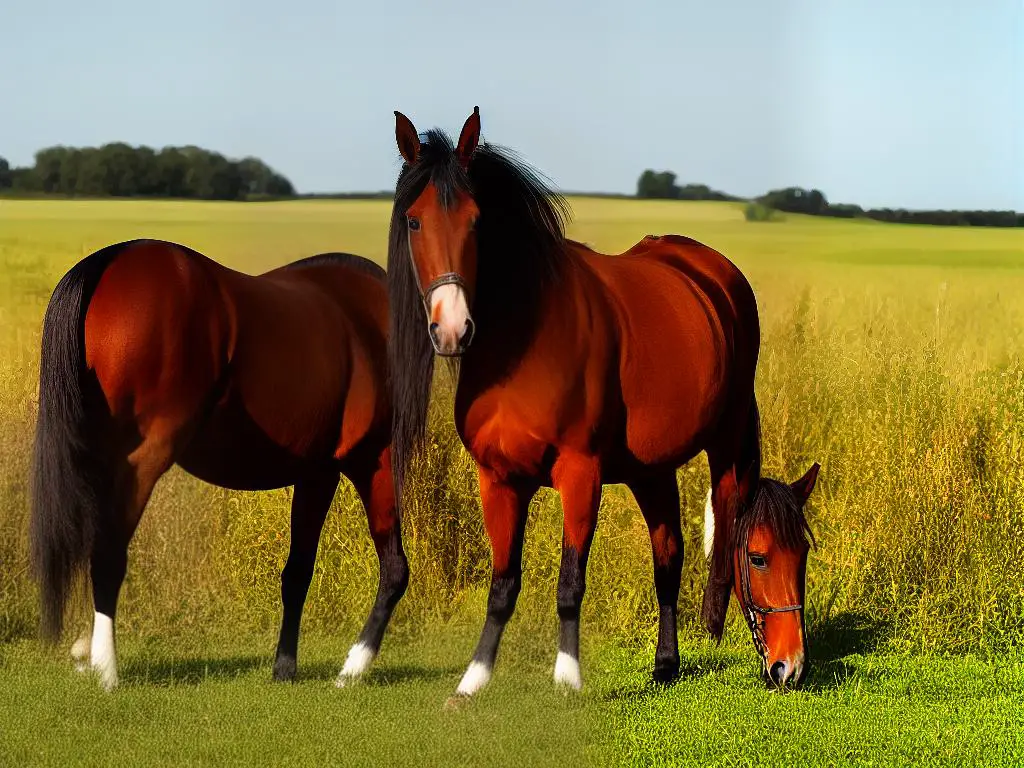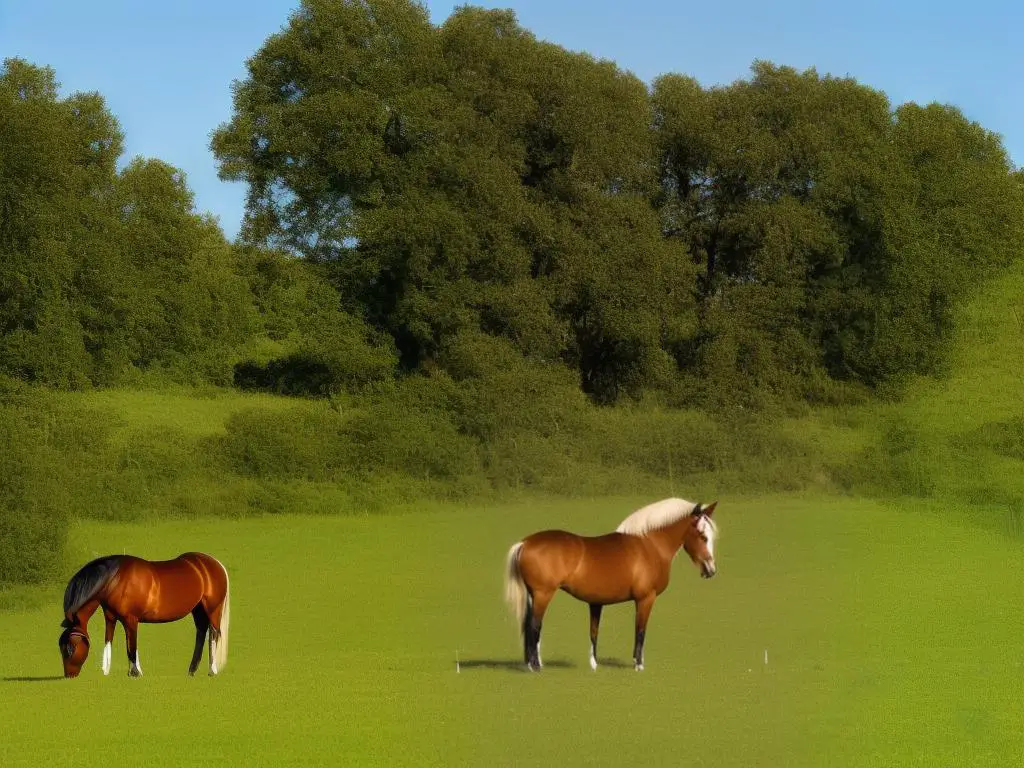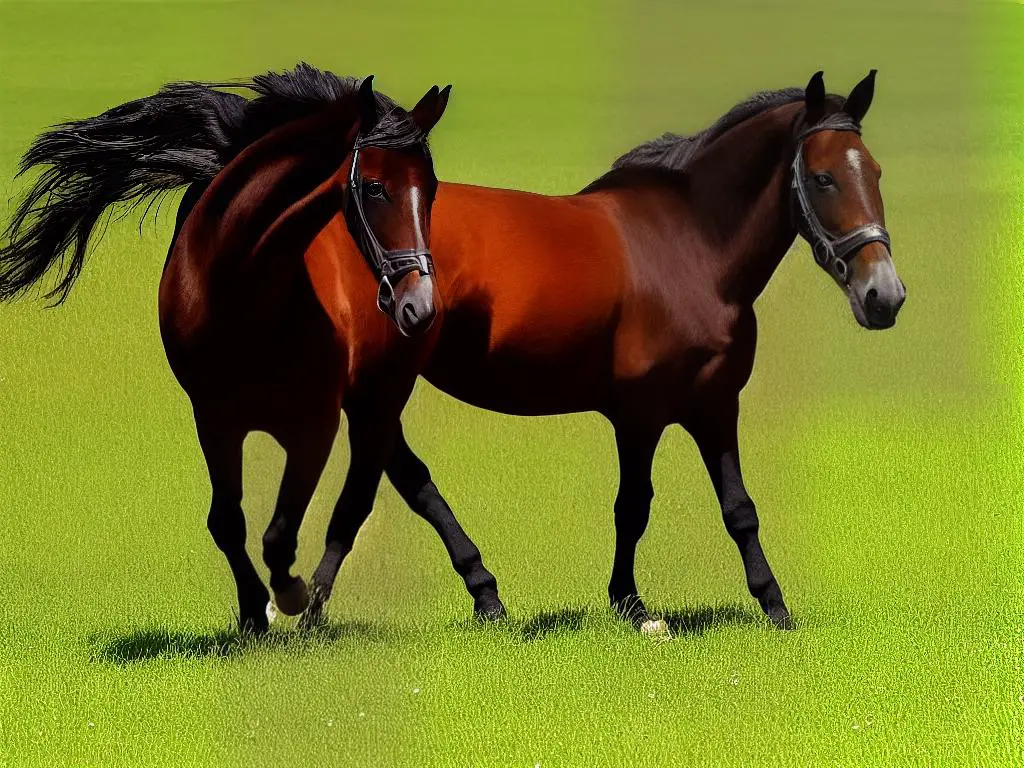Engulfed in the rich tapestry of equestrian lore is the Poisitvin Mule Horse, a marvel of intricate breeding and unique characteristics that have positioned it among the distinctive breeds of horses. This regal breed, shaped by centuries of careful selection and meticulous mating strategies, stands as a beacon of the deep connection between humanity and our equine companions. The following essay ventures into the intriguing world of Poisitvin Mule Horses, delving into their origin and breeding practices, exploring their physical characteristics and health issues, moreover, shedding light on their behavioral traits, training methods, and unyielding spirit.
Table of Contents (Horspedia)
Origin and breeding of Poisitvin Mule Horses
Origins: The French Root of Poitivin Mule Horse
The Poitou mule, also known as Poitivin Mule Horse, has a rich history that dates back to the Roman era. Serving as strong and reliable animals in the vineyards and farms of Western France, these equines have been an essential part of human life for centuries.
The mule’s forefathers are the endangered Poitou Donkey and the native breed of draft horses known as the Mulassière du Poitou. The heritage of this breed predominantly traces back to the Poitou region of France. The breeding process involved selecting the strongest and largest mares to produce offspring that displayed the same traits leading to the birth of this potent and hearty mule breed.
Breeding Techniques: A Marriage of Strength and Endurance
The mating process of Poitivin Mule Horse involves the Poitou Donkey and the Mulassière du Poitou mare. Traditionally, a French breeder would select the best donkey stallion and horse mare for this cross-breeding that typically happened in spring.
The mare was frequently chosen for size, temperament, and health while the donkey stallion was selected primarily for his size, characteristics, and proven mule-foal track record. This meticulous selection process has ensured that the Poitivin Mule Horses have consistently displayed high qualities over the centuries.
Unique Characteristics: More Than Just Horsepower
Looking at a Poitivin Mule Horse, the first thing you notice is their size. These are large animals, standing at heights between 15 and 16 hands high, sometimes even taller. This trait is a result of the careful selection process that choses large mares to breed with the donkey stallion.
Further, the Poitivin Mule Horses are known for their distinctive brown or bay coat, offering a certain aesthetic appeal. They have earned the name ‘gros noir’ or ‘big black,’ but they do come in a variety of colors. The mule’s coat, however, is thicker and denser than a horse’s, owing to its donkey heritage, making it perfect for colder climates.
In terms of temperament, Poitivin Mule Horses have a reputation as calm and intelligent animals. They’re known for their strength and endurance, and despite being a work-centric breed, they’re also friendly and approachable.
These mules have the resilience, strength, and longevity that sets them apart. Often outliving their horse counterparts, Poitivin Mule Horses usually continue working into their late twenties, highlighting their excellent physical capability.
Current State: Preserving a Legacy
In recent times, with the advent of technological advancements in the agricultural domain, the demand for the Poitivin Mule Horse has seen a significant decline. Consequently, the breed’s population has decreased sharply and is considered endangered by myriad global rescue and preservation organizations.
Yet, there are hardy breeders in France and North America who persist in their attempts to rehabilitate this breed, incrementing its significance and population. Indeed, the Poitivin Mule Horses, besides serving as hearty work animals, also function as critical markers of France’s rural history and cultural legacy.

Physical characteristics and health of Poisitvin Mule Horses
An Overview of Poitivin Mule Horses’ Physical Attributes
A Poitivin Mule Horse, celebrated for its amazing strength and adaptability, doesn’t exactly fall under the term ‘breed.’ Rather, it’s a type of mule resulting from the strategic cross-breeding of a Poitevin mare and a donkey. The objective of this selective breeding is to amalgamate the prime qualities of the parents into the mule.
Poitivin Mules are large, muscular, and hardy, typically reaching a height of 15 to 16 hands (60 to 64 inches). Their height and shape make them exceptional work animals, capable of riding, pulling, and labor-heavy tasks. As mules, they usually have a slender, narrow body, resembling a horse in their silhouette but embodying the hardy, muscular form of a donkey.
A typical Poisitvin Mule Horse’s coat is quite diverse, showcasing a variety of colors inherited from their parents. You might spot them in hues of black, brown, tan, and grey. Each mule also showcases exclusive markings, offering an additional level of distinction from others.
Health and Longevity in Poisitvin Mule Horses
Poisitvin Mule Horses are renowned for their exceptional health and longevity. A mule’s lifespan is generally longer than a horse’s, often living up to 30 to 50 years with proper care. Their robust vitality stems from the phenomena called “hybrid vigor”, which implies that cross-breeds tend to be healthier and live longer than their purebred counterparts.
However, like any equine, Poisitvin Mule Horses are not entirely free from health concerns. They can potentially face similar health issues as horses and donkeys, including but not limited to, colic, metabolic disorders, hoof issues, and dental problems. Regular veterinary check-ups and prompt intervention at the first sign of illness can ensure your Poisitvin Mule Horse remains healthy and lives a long, productive life.
Special Dietary Considerations for Poisitvin Mule Horses
When it comes to diet, Poisitvin Mule Horses carry the donkey’s ability to thrive on minimal, poor-quality forage. However, for optimal health and performance, a balanced diet is crucial. The diet should be fiber-rich and low in sugar and starch. It’s advisable to feed them hay, grass, and limited grains along with essential minerals and vitamins.
Monitoring their weight is mandatory, as Mule Horses, like their donkey parents, have a high propensity for obesity, and a condition called hyperlipemia can occur if they are allowed to become too thin. Thus, providing sufficient nutrition while avoiding overfeeding is a significant balance to manage when caring for these robust creatures.
Poisitvin Mule Horses are renowned for their tenacity, durable health, and a careful mixture of power and stamina. Their vitality and optimal health are closely tied to regular veterinary check-ups, nourishing feeding habits, and habitual exercise.

Behavioral traits and training of Poisitvin Mule Horses
Unraveling the Unique Traits of Poisitvin Mule Horses
In the wide-ranging world of domesticated equine species, understanding the unique behavioral characteristics of Poisitvin Mule Horses is fascinating. Resulting from the crossbreeding of a female horse (mare) and a male donkey (jack), these mules exhibit a blend of characteristics from both their parent species. Generally, they demonstrate a cooperative demeanor, high intelligence, and superior working skills.
Temperament and Intelligence of Poisitvin Mule Horses
Poisitvin Mule Horses, unlike their equine relatives, are innately patient and remarkably versatile in the spectrum of tasks they can perform. Their temperamental qualities, likely inherited from their donkey fathers, largely contribute to their reputation as calm, resilient creatures.
Another significant attribute of the Poisitvin Mule Horse is its intellectual capacity. They are distinctly quick learners, capable of grasping new cues and commands effectively, a characteristic that undoubtedly heightens their appeal as a working animal. Their intelligence, while not measured in human terms, is demonstrated by their ability to react in a measured manner to unusual situations or threats, avoiding impulsive reactions that may lead to injury or distress.
Working Abilities of Poisitvin Mule Horses
Poisitvin Mule Horses are known for their robust endurance and minimal need for rest. They are extensively employed in fields such as farming, forestry, driving, and even leisure activities for these attributes. The adaptability of Poisitvin Mule Horses is seen in their capability to work in various terrains and climates, demonstrating physical toughness and resilience inherited from their donkey parentage.
Training Poisitvin Mule Horses
Training Poisitvin Mule Horses is a task that demands consistency, patience, and perseverance. Leveraging their intelligent and receptive nature is key to efficient training. It is recommended to introduce new tasks or commands gradually and maintain a uniform pattern of rewards and penalties to catalyze learning.
It’s important to remember that the intelligence of these animals can make them somewhat obstinate if they do not trust or respect their human handlers. Building a rapport based on trust is therefore an essential aspect of training in the early stages.
Additionally, using modern behaviorist techniques such as positive reinforcement to reward desired behavior can prove beneficial in training. A balanced approach integrating firm boundaries and compassionate understanding can help to shape a Poisitvin Mule Horse to reach its highest potential.
In conclusion
Poisitvin Mule Horses, with their distinct blend of admirable traits, enhanced intellectual capacity, and robust resilience, are a popular choice for both work and pleasure purposes. Their training, while demanding consistency, patience, and endurance, can result in a well-rounded, capable, and loyal companion in various equine roles.

Resonating through the corridors of time, the story of the Poisitvin Mule Horse is a testament to the unyielding spirit and unique aptitude these creatures possess. Their heritage, intricately woven into the tapestry of their capabilities and characteristics, accentuating the raw beauty and intelligence inherent in their kind. Their physical prowess, combined with a sharp mind, give them a unique standing in the equine world. Simultaneously, their training techniques highlight the indomitable essence of human-equine partnership, fostering a boundless world for these majestic creatures. Delving into their world, we have only broadened our understanding of their evolution and splendor, realizing that there is a profound connection waiting to be explored between humans and Poisitvin Mule Horses.
